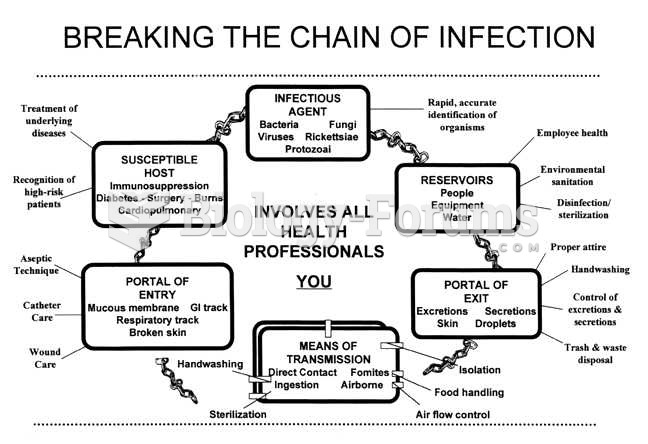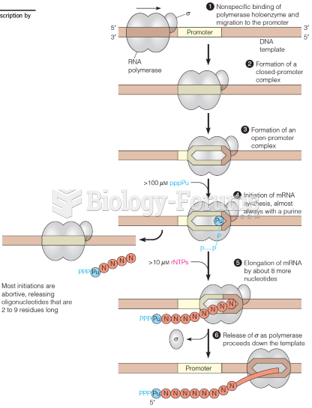Which of the following characterizes the polymerase chain reaction (PCR)?
a.
produces multiple copies of DNA segments
b.
requires small amount of the source DNA
c.
the key to the process is a thermally stable enzyme
d.
involves temperature cycling
e.
all of these
Question 2Instructions: Match each of the following terms to a structure from the list below. There is only one correct structure for each term and structures may be used more than once.
A.
Sanger dideoxy method
B.
GAUCGUAAA
C.
Watson-Crick
D.
translation
E.

F.

G.
transcription
H.
Maxam-Gilbert method
I.
AUGGCUGAG
J.
replication
K.

L.

M.
AGATCGCTC
- process by which mRNA is synthesized
Question 3Instructions: Match each of the following terms to a structure from the list below. There is only one correct structure for each term and structures may be used more than once.
A.
Sanger dideoxy method
B.
GAUCGUAAA
C.
Watson-Crick
D.
translation
E.

F.

G.
transcription
H.
Maxam-Gilbert method
I.
AUGGCUGAG
J.
replication
K.

L.

M.
AGATCGCTC
2'-deoxyadenosine 5'-phosphate
Question 4Instructions: Match each of the following terms to a structure from the list below. There is only one correct structure for each term and structures may be used more than once.
A.
Sanger dideoxy method
B.
GAUCGUAAA
C.
Watson-Crick
D.
translation
E.

F.

G.
transcription
H.
Maxam-Gilbert method
I.
AUGGCUGAG
J.
replication
K.

L.

M.
AGATCGCTC
RNA base sequence complementary to the DNA base sequence which codes for Leu-Ala-Phe:
CTAGCATTT
Question 5Instructions: Match each of the following terms to a structure from the list below. There is only one correct structure for each term and structures may be used more than once.
A.
Sanger dideoxy method
B.
GAUCGUAAA
C.
Watson-Crick
D.
translation
E.

F.

G.
transcription
H.
Maxam-Gilbert method
I.
AUGGCUGAG
J.
replication
K.

L.

M.
AGATCGCTC
DNA sequencing method for the human genome
Question 6Instructions: Match each of the following terms to a structure from the list below. There is only one correct structure for each term and structures may be used more than once.
A.
Sanger dideoxy method
B.
GAUCGUAAA
C.
Watson-Crick
D.
translation
E.

F.

G.
transcription
H.
Maxam-Gilbert method
I.
AUGGCUGAG
J.
replication
K.

L.

M.
AGATCGCTC
a pyrimidine nucleoside
Question 7Instructions: Match each of the following terms to a structure from the list below. There is only one correct structure for each term and structures may be used more than once.
A.
Sanger dideoxy method
B.
GAUCGUAAA
C.
Watson-Crick
D.
translation
E.

F.

G.
transcription
H.
Maxam-Gilbert method
I.
AUGGCUGAG
J.
replication
K.

L.

M.
AGATCGCTC
uridine
Question 8Instructions: Match each of the following terms to a structure from the list below. There is only one correct structure for each term and structures may be used more than once.
A.
Sanger dideoxy method
B.
GAUCGUAAA
C.
Watson-Crick
D.
translation
E.

F.

G.
transcription
H.
Maxam-Gilbert method
I.
AUGGCUGAG
J.
replication
K.

L.

M.
AGATCGCTC
DNA base sequence with cytosine at the 3' end.
Question 9Instructions: Match each of the following terms to a structure from the list below. There is only one correct structure for each term and structures may be used more than once.
A.
Sanger dideoxy method
B.
GAUCGUAAA
C.
Watson-Crick
D.
translation
E.

F.

G.
transcription
H.
Maxam-Gilbert method
I.
AUGGCUGAG
J.
replication
K.

L.

M.
AGATCGCTC
RNA base sequence with guanine at the 3' end.
Question 10Instructions: Match each of the following terms to a structure from the list below. There is only one correct structure for each term and structures may be used more than once.
A.
Sanger dideoxy method
B.
GAUCGUAAA
C.
Watson-Crick
D.
translation
E.

F.








